| Listing 1 - 10 of 14 | << page >> |
Sort by
|
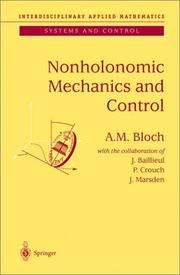
ISBN: 0387955356 Year: 2003 Publisher: New York : Springer,
Abstract | Keywords | Export | Availability | Bookmark
 Loading...
Loading...Choose an application
- Reference Manager
- EndNote
- RefWorks (Direct export to RefWorks)
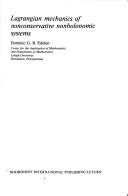
ISBN: 9028600779 Year: 1977 Publisher: Leyden Noordhoff
Abstract | Keywords | Export | Availability | Bookmark
 Loading...
Loading...Choose an application
- Reference Manager
- EndNote
- RefWorks (Direct export to RefWorks)
Book
ISBN: 1316055876 1316053504 1139047523 Year: 2016 Publisher: New York, NY : Cambridge University Press,
Abstract | Keywords | Export | Availability | Bookmark
 Loading...
Loading...Choose an application
- Reference Manager
- EndNote
- RefWorks (Direct export to RefWorks)
This book is ideal for teaching students in engineering or physics the skills necessary to analyze motions of complex mechanical systems such as spacecraft, robotic manipulators, and articulated scientific instruments. Kane's method, which emerged recently, reduces the labor needed to derive equations of motion and leads to equations that are simpler and more readily solved by computer, in comparison to earlier, classical approaches. Moreover, the method is highly systematic and thus easy to teach. This book is a revision of Dynamics: Theory and Applications by T. R. Kane and D. A. Levinson and presents the method for forming equations of motion by constructing generalized active forces and generalized inertia forces. Important additional topics include approaches for dealing with finite rotation, an updated treatment of constraint forces and constraint torques, an extension of Kane's method to deal with a broader class of nonholonomic constraint equations, and other recent advances.
Motion --- Constraints (Physics) --- Nonholonomic dynamical systems. --- Structural optimization. --- Structural dynamics. --- Mathematical models.
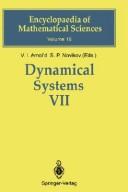
ISBN: 3540181768 0387181768 3642057381 366206796X 9780387181769 Year: 1994 Volume: 16 Publisher: Berlin: Springer,
Abstract | Keywords | Export | Availability | Bookmark
 Loading...
Loading...Choose an application
- Reference Manager
- EndNote
- RefWorks (Direct export to RefWorks)
51 --- Mathematics --- Differentiable dynamical systems. --- Nonholonomic dynamical systems. --- 51 Mathematics --- Differentiable dynamical systems --- Nonholonomic dynamical systems --- Dynamical systems, Nonholonomic --- Non-holonomic systems --- Nonholonomic systems --- Differential dynamical systems --- Dynamical systems, Differentiable --- Dynamics, Differentiable --- Differential equations --- Global analysis (Mathematics) --- Topological dynamics
Book
ISBN: 1282761676 9786612761676 9814289493 9789814289498 9789814289481 9814289485 9781282761674 Year: 2010 Publisher: Singapore ; Hackensack, NJ : World Scientific,
Abstract | Keywords | Export | Availability | Bookmark
 Loading...
Loading...Choose an application
- Reference Manager
- EndNote
- RefWorks (Direct export to RefWorks)
This book gives a modern differential geometric treatment of linearly nonholonomically constrained systems. It discusses in detail what is meant by symmetry of such a system and gives a general theory of how to reduce such a symmetry using the concept of a differential space and the almost Poisson bracket structure of its algebra of smooth functions. The above theory is applied to the concrete example of Carathéodory's sleigh and the convex rolling rigid body. The qualitative behavior of the motion of the rolling disk is treated exhaustively and in detail. In particular, it classifies all mot
Nonholonomic dynamical systems. --- Geometry, Differential. --- Rigidity (Geometry) --- Caratheodory measure. --- Measure, Caratheodory --- Algebra, Boolean --- Measure theory --- Geometric rigidity --- Rigidity theorem --- Discrete geometry --- Differential geometry --- Dynamical systems, Nonholonomic --- Non-holonomic systems --- Nonholonomic systems --- Differentiable dynamical systems --- Rigidity (Geometry).
Book
ISBN: 0821815830 9780821815830 Year: 1972 Volume: 33 Publisher: Providence (R.I.): American mathematical society,
Abstract | Keywords | Export | Availability | Bookmark
 Loading...
Loading...Choose an application
- Reference Manager
- EndNote
- RefWorks (Direct export to RefWorks)
Mathematical physics --- Classical mechanics. Field theory --- Dynamics --- Nonholonomic dynamical systems --- 51-74 --- 51 --- 681.3*J2 --- Dynamical systems --- Kinetics --- Mathematics --- Mechanics, Analytic --- Force and energy --- Mechanics --- Physics --- Statics --- Dynamical systems, Nonholonomic --- Non-holonomic systems --- Nonholonomic systems --- Differentiable dynamical systems --- Mathematics--?-74 --- Physical sciences and engineering (Computer applications) --- Nonholonomic dynamical systems. --- 681.3*J2 Physical sciences and engineering (Computer applications) --- 51 Mathematics --- 51-74 Mathematics--?-74 --- Solides. --- Solids. --- Systèmes non-holonomes. --- Mécanique --- Mécanique --- Systèmes non-holonomes.
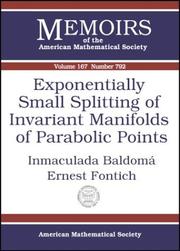
ISBN: 0821834452 Year: 2004 Publisher: Providence, R.I. American Mathematical Society
Abstract | Keywords | Export | Availability | Bookmark
 Loading...
Loading...Choose an application
- Reference Manager
- EndNote
- RefWorks (Direct export to RefWorks)
Ergodic theory. Information theory --- Ordinary differential equations --- 514.8 --- Geometric study of objects of mechanics and physics --- 514.8 Geometric study of objects of mechanics and physics --- Nonholonomic dynamical systems. --- Hamiltonian systems. --- Lagrangian points. --- Hamiltonian systems --- Lagrangian points --- Nonholonomic dynamical systems --- Dynamical systems, Nonholonomic --- Non-holonomic systems --- Nonholonomic systems --- Differentiable dynamical systems --- Equilibrium points, Lagrangian --- Lagrangian equilibrium points --- Libration points --- Points, Lagrangian --- Orbits --- Hamiltonian dynamical systems --- Systems, Hamiltonian
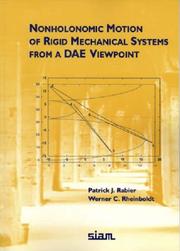
ISBN: 089871446X Year: 2000 Publisher: Philadelphia (Pa.) : SIAM,
Abstract | Keywords | Export | Availability | Bookmark
 Loading...
Loading...Choose an application
- Reference Manager
- EndNote
- RefWorks (Direct export to RefWorks)
This book contains a unique description of the nonholonomic motion of systems of rigid bodies by differential algebraic systems. Nonholonomic Motion of Rigid Mechanical Systems from a DAE Viewpoint focuses on rigid body systems subjected to kinematic constraints (constraints that depend on the velocities of the bodies, e.g., as they arise for nonholonomic motions) and discusses in detail how the equations of motion are developed. The authors show that such motions can be modeled in terms of differential algebraic equations (DAEs), provided only that the correct variables are introduced. Several issues are investigated in depth to provide a sound and complete justification of the DAE model. These issues include the development of a generalized Gauss principle of least constraint, a study of the effect of the failure of an important full-rank condition, and a precise characterization of the state spaces.
531.3 --- Differential-algebraic equations --- -Dynamics, Rigid --- Nonholonomic dynamical systems --- Dynamical systems, Nonholonomic --- Non-holonomic systems --- Nonholonomic systems --- Differentiable dynamical systems --- Rigid dynamics --- Algebraic-differential equations --- Differential-algebraic systems --- Equations, Algebraic-differential --- Equations, Differential-algebraic --- Systems, Differential-algebraic --- Differential equations --- Dynamics. Kinetics --- Numerical solutions --- Dynamics, Rigid. --- Nonholonomic dynamical systems. --- Numerical solutions. --- 531.3 Dynamics. Kinetics --- Dynamics, Rigid --- Numerical analysis --- Differentiable dynamical systems. --- Systèmes dynamiques --- Dynamics, rigid --- Dynamique des corps rigides
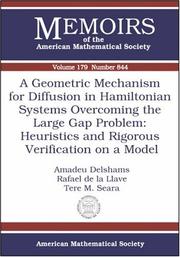
ISBN: 0821838245 Year: 2006 Publisher: Providence, R.I. American Mathematical Society
Abstract | Keywords | Export | Availability | Bookmark
 Loading...
Loading...Choose an application
- Reference Manager
- EndNote
- RefWorks (Direct export to RefWorks)
Ergodic theory. Information theory --- Ordinary differential equations --- Classical mechanics. Field theory --- 51 <082> --- 514.8 --- 51 <082.1> --- Mathematics--Feestbundels. Festschriften --- Geometric study of objects of mechanics and physics --- Mathematics--Series --- 514.8 Geometric study of objects of mechanics and physics --- 51 <082> Mathematics--Feestbundels. Festschriften --- Nonholonomic dynamical systems. --- Mechanics. --- Differential equations --- Mécanique --- Équations différentielles --- Qualitative theory. --- Théorie qualitative --- Mechanics --- Nonholonomic dynamical systems --- Dynamical systems, Nonholonomic --- Non-holonomic systems --- Nonholonomic systems --- Differentiable dynamical systems --- Classical mechanics --- Newtonian mechanics --- Physics --- Dynamics --- Quantum theory --- 517.91 Differential equations --- Qualitative theory --- 517.91 --- Numerical solutions --- Mécanique. --- Théorie qualitative. --- Numerical solutions&delete&
Book
ISBN: 3642099386 3540858466 9786612364143 1282364146 3540858474 Year: 2009 Publisher: Berlin ; London : Springer,
Abstract | Keywords | Export | Availability | Bookmark
 Loading...
Loading...Choose an application
- Reference Manager
- EndNote
- RefWorks (Direct export to RefWorks)
A general approach to the derivation of equations of motion of as holonomic, as nonholonomic systems with the constraints of any order is suggested. The system of equations of motion in the generalized coordinates is regarded as a one vector relation, represented in a space tangential to a manifold of all possible positions of system at given instant. The tangential space is partitioned by the equations of constraints into two orthogonal subspaces. In one of them for the constraints up to the second order, the motion low is given by the equations of constraints and in the other one for ideal constraints, it is described by the vector equation without reactions of connections. In the whole space the motion low involves Lagrangian multipliers. It is shown that for the holonomic and nonholonomic constraints up to the second order, these multipliers can be found as the function of time, positions of system, and its velocities. The application of Lagrangian multipliers for holonomic systems permits us to construct a new method for determining the eigenfrequencies and eigenforms of oscillations of elastic systems and also to suggest a special form of equations for describing the system of motion of rigid bodies. The nonholonomic constraints, the order of which is greater than two, are regarded as programming constraints such that their validity is provided due to the existence of generalized control forces, which are determined as the functions of time. The closed system of differential equations, which makes it possible to find as these control forces, as the generalized Lagrange coordinates, is compound. The theory suggested is illustrated by the examples of a spacecraft motion. The book is primarily addressed to specialists in analytic mechanics.
Mathematics -- Differential Equations -- General. --- Mathematics. --- Nonholonomic dynamical systems. --- Nonholonomic dynamical systems --- Civil Engineering --- Geometry --- Civil & Environmental Engineering --- Mathematics --- Engineering & Applied Sciences --- Physical Sciences & Mathematics --- Differentiable dynamical systems. --- Dynamical systems, Nonholonomic --- Non-holonomic systems --- Nonholonomic systems --- Differential dynamical systems --- Dynamical systems, Differentiable --- Dynamics, Differentiable --- Engineering. --- Mechanics. --- Computational intelligence. --- Mechanics, Applied. --- Theoretical and Applied Mechanics. --- Computational Intelligence. --- Applied mechanics --- Engineering, Mechanical --- Engineering mathematics --- Intelligence, Computational --- Artificial intelligence --- Soft computing --- Classical mechanics --- Newtonian mechanics --- Physics --- Dynamics --- Quantum theory --- Construction --- Industrial arts --- Technology --- Differentiable dynamical systems --- Differential equations --- Global analysis (Mathematics) --- Topological dynamics --- Mechanics, applied. --- Classical Mechanics.
| Listing 1 - 10 of 14 | << page >> |
Sort by
|

 Search
Search Feedback
Feedback About UniCat
About UniCat  Help
Help News
News